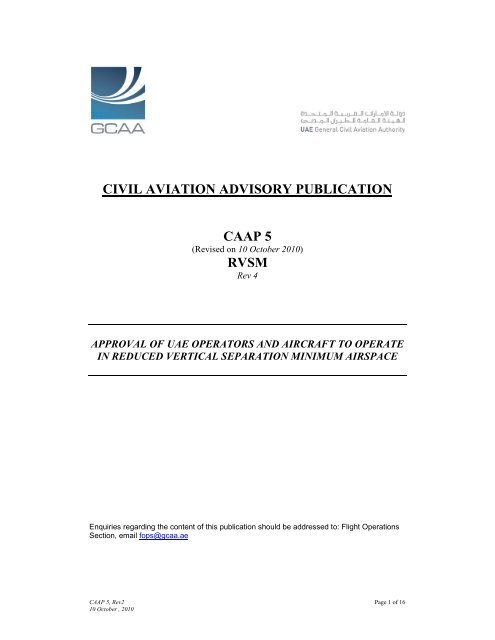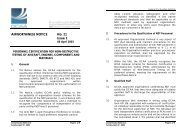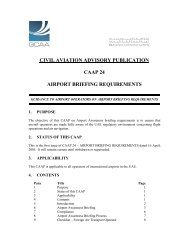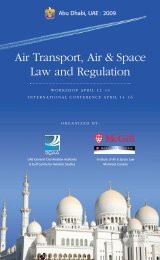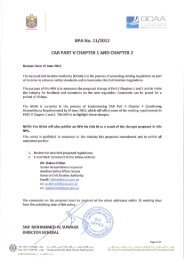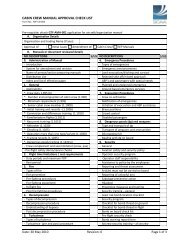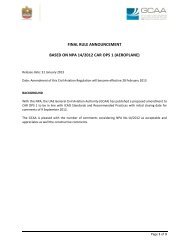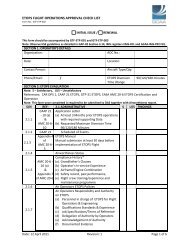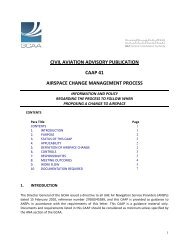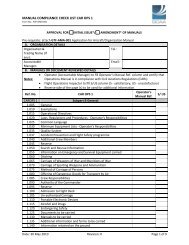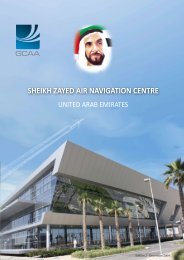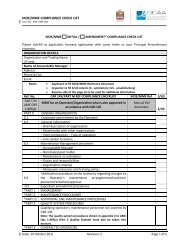CIVIL AVIATION ADVISORY PUBLICATION CAAP 5 RVSM
CIVIL AVIATION ADVISORY PUBLICATION CAAP 5 RVSM
CIVIL AVIATION ADVISORY PUBLICATION CAAP 5 RVSM
- No tags were found...
You also want an ePaper? Increase the reach of your titles
YUMPU automatically turns print PDFs into web optimized ePapers that Google loves.
<strong>CIVIL</strong> <strong>AVIATION</strong> <strong>ADVISORY</strong> <strong>PUBLICATION</strong><strong>CAAP</strong> 5(Revised on 10 October 2010)<strong>RVSM</strong>Rev 4APPROVAL OF UAE OPERATORS AND AIRCRAFT TO OPERATEIN REDUCED VERTICAL SEPARATION MINIMUM AIRSPACEEnquiries regarding the content of this publication should be addressed to: Flight OperationsSection, email fops@gcaa.ae<strong>CAAP</strong> 5, Rev2 Page 1 of 1610 October , 2010
1 PURPOSEThis guidance material is intended for operators of UAE aircraft planning to operatein Reduced Vertical Separation Minima (<strong>RVSM</strong>) airspace. This <strong>CAAP</strong> providesinformation on the implementation plan, required equipment, the approval process, aswell as guidance on operational procedures and training. This <strong>CAAP</strong> providesmethods acceptable for determining compliance with ICAO, JAA and FAArequirements. GCAA procedures for processing applications are also provided.Operators must be aware that airspace restrictions and operational penalties may beincurred if the aircraft is not approved for operations in <strong>RVSM</strong> airspace.2 STATUS OF THIS <strong>CAAP</strong>This first <strong>CAAP</strong> was issued 01 September, 2003 to the second edition of <strong>CAAP</strong> 5,<strong>RVSM</strong>, dated 01 January, 2003, and the 3rd edition (Rev 3) is issued 10 October2010. The change is replacement of approval to indicate in the operationsspecifications and additional requirement on periodic height keeping as well as list of<strong>RVSM</strong> approved aircraft in the www.midrma.com3 APPLICABILITYAll UAE registered aircraft planning to operate in <strong>RVSM</strong> airspace shall be required toobtain an operational approval from the GCAA before the commencement ofoperations. Operations in the North Atlantic (NAT) Region, which includes <strong>RVSM</strong>airspace, also require an additional MNPS approval (ref <strong>CAAP</strong> 6 MNPS) andoperations in European Upper Information Regions (UIR), which can also be <strong>RVSM</strong>airspace, require a Basic Area Navigation approval (ref to <strong>CAAP</strong> 2 BRNAV).<strong>CAAP</strong> 5, Rev2 Page 2 of 1610 October , 2010
4 CONTENTSPara Title Page1 PURPOSE ............................................................................................................... 22 STATUS OF THIS <strong>CAAP</strong> ..................................................................................... 23 APPLICABILITY .................................................................................................. 24 CONTENTS ........................................................................................................... 35 BACKGROUND .................................................................................................... 46 REFERENCES ....................................................................................................... 47 AIRCRAFT EQUIPMENT FOR <strong>RVSM</strong> OPERATIONS ..................................... 57.1 <strong>RVSM</strong> .............................................................................................................. 57.2 ACAS .............................................................................................................. 58 APPLICATION & OPERATIONAL APPROVAL PROCESS ............................ 58.1 General ............................................................................................................ 58.2 Content of Operator <strong>RVSM</strong> Application ........................................................ 68.3 Overflight Assessment .................................................................................... 78.4 Approval Process ............................................................................................. 89 TRAINING & OPERATING PROCEDURES .................................................... 109.1 Introduction ................................................................................................... 109.2 Training ......................................................................................................... 109.3 Flight Planning .............................................................................................. 119.4 Pre-flight Procedures ..................................................................................... 119.5 Procedures Prior to <strong>RVSM</strong> Airspace Entry ................................................... 129.6 In-flight Procedures ....................................................................................... 129.7 Contingency procedures after entering <strong>RVSM</strong> airspace ............................... 139.8 Post Flight ..................................................................................................... 1410 OPERATOR/GCAA OVERSIGHT ................................................................. 1410.1 Operator Responsibilities .......................................................................... 1410.2 <strong>RVSM</strong> PERIODIC MONITORING PROGRAM ..................................... 1510.3 GCAA Action ............................................................................................ 15Appendix 1.Web References on application form 16<strong>CAAP</strong> 5, Rev2 Page 3 of 1610 October , 2010
5 BACKGROUNDIn 1982 the International Civil Aviation Organisation (ICAO) initiated a series ofworld-wide studies to assess the feasibility of a reduction of the Vertical SeparationMinimum (VSM) above FL 290 from 2000 ft to 1000 ft. The studies were coordinatedby the Review of the General Concept of Separation Panel (RGCSP), whichincluded representation from the International Air Transport Association (IATA),International Federation of Airline Pilots Associations (IFALPA) and the InternationalFederation of Air Traffic Controllers Associations (IFATCA). The principal benefits,which the implementation of the reduced VSM were expected to provide, were atheoretical doubling of the airspace capacity between FL 290 and FL 410 and theopportunity for aircraft to operate at or closer to their optimum flight levels, withresulting fuel economy and time savings. Studies and data collections were conductedto determine the height keeping accuracy of the current aircraft population at andabove FL 290 and the causes of height deviations > 300 ft as well as to definecorrective measures. As a result, the RGCSP concluded that a 1000 ft VSM betweenFL 290 and FL 410 was technically feasible without imposing unreasonablydemanding technical or operational requirements. The ICAO Air NavigationCommission endorsed these findings in 1990. The North Atlantic (NAT) wasidentified as the region best suited to the first application of the new minimumbecause of the better than average height keeping accuracy shown by NAT MinimumNavigation Performance Specifications (NAT MNPS) approved aircraft, together withthe predominantly one-way traffic flow in the NAT Region. The trials were successfuland resulted in <strong>RVSM</strong> being adopted.This concept was introduced into designated European airspace on 24 January, 2002and designated Pacific and Asian airspace, as well as FANS routes, have a <strong>RVSM</strong>requirement. The implementation date for <strong>RVSM</strong> in designated Middle East airspace(MID) will be 27 November, 2003.The new height keeping monitoring requirement for UAE every two years or 1000 hrsis introduced on 18 November 20106 REFERENCES(a)(b)(c)Federal Aviation Administration (FAA)(i) Document 91 – <strong>RVSM</strong> – Interim Guidance Material on the Approvalof Operators/Aircraft for <strong>RVSM</strong> Operations.International Civil Aviation Organisation (ICAO)(i) ICAO Doc. 9574 – Manual on the Implementation of a 300 m (1000 ft)Vertical Separation Minimum Between FL 290 – FL 410 Inclusive.(ii) ICAO Doc. 7030 – Regional Supplementary Procedures (forappropriate region)Joint Aviation Authorities (JAA)(i) JAA Information Leaflet No. 6 – Guidance Material on the Approvalof Aircraft and Operators for flight in Airspace above Flight Level 290where a 300 m (1000 ft) Vertical Separation Minimum is applied(replaces JAA IL No. 23).<strong>CAAP</strong> 5, Rev2 Page 4 of 1610 October , 2010
7 AIRCRAFT EQUIPMENT FOR <strong>RVSM</strong> OPERATIONS7.1 <strong>RVSM</strong>The minimum equipment fit will be subject to GCAA Airworthiness approval andshould be:(a)(b)(c)(d)Two independent altitude measurement systems. Each system should becomposed of the following elements:(i) Cross-coupled static source/system, provided with ice protection iflocated in areas subject to ice accretion.(ii) Equipment for measuring static pressure sensed by the static source,converting it to pressure altitude and displaying the pressure altitudeto the flight crew.(iii) Equipment for providing a digitally coded signal corresponding tothe displayed pressure altitude, for automatic altitude reportingpurposes.(iv) Static source error correction (SSEC), if needed to meetperformance requirements; and(v) The equipment fit should provide reference signals for automaticcontrol and alerting at a selected altitude. These signals shouldpreferably be derived from an altitude measurement system.One SSR altitude reporting transponder. If only one is fitted, it shouldhave the capability for switching to operate from either altitudemeasurement system.An altitude alert system.An automatic altitude control system.7.2 ACASACAS Version II (TCAS Version 7.0) has improved compatibility with <strong>RVSM</strong> andICAO Annex 6 has implemented the carriage of ACAS in turbine-engine aeroplanesabove 15000 kg and certified for more than 30 passengers as a Standard from 01January, 2003. However this version is already mandatory for European <strong>RVSM</strong>airspace operations and in the UAE FIR after 01 January, 2002. After 01 January,2005, the ICAO Standard will apply for all turbine engined aeroplanes above 5700 kgor certified for more than 19 passengers. It is expected that <strong>RVSM</strong> operationsthroughout the MID region will require ACAS II.8 APPLICATION & OPERATIONAL APPROVAL PROCESS8.1 GeneralThis paragraph gives detailed guidance on the required content of operationalpractices and procedures. It also describes the steps in the operational approvalprocess and the granting of approval to operate in <strong>RVSM</strong> airspace. The approvalprocess involves the operator applying for a <strong>RVSM</strong> approval for an aircraft; theGCAA determining the airworthiness requirements; and the GCAA notifying theappropriate Regional Monitoring Agency (RMA) in this case, MIDRMA that theaircraft is eligible for height monitoring. Notification to the RMA is only made after<strong>CAAP</strong> 5, Rev2 Page 5 of 1610 October , 2010
the operator meets the airworthiness requirements and the GCAA is satisfied that eachoperator can maintain high levels of height keeping performance. Once the RMA hasconfirmed the height accuracy, the GCAA further evaluates operational areas such asflight crew training, flight dispatch and operations manuals before a final Approvalcan be issued in the operations specifications.Normally if the aircraft fly through UK / Europe where the monitoring is within theirroute, we recommend to apply height monitoring even before registrations, as far asthe mode S is recognised and height keeping can be monitored.8.2 Content of Operator <strong>RVSM</strong> ApplicationThe following describes the material that an operator should provide to the GCAA forevaluation, preferably at least 60 days before the intended start of <strong>RVSM</strong> operations.(Refer to Appendix 1 – for www.midrma.com websites for Forms)8.2.1 Airworthiness(a) Airworthiness Documents. Documentation should be available to showthat the aircraft has been approved for <strong>RVSM</strong> by the appropriateairworthiness authorities (eg; State of Manufacture). This documentationmust be either the Aircraft Flight Manual (AFM), Service Bulletin (S/B)or Supplemental Type Certificate (STC).(b) Description of Aircraft Equipment A description of the aircraftequipment appropriate to operations in an <strong>RVSM</strong> environment.(c) Maintenance. At the time application is made for operational approval,the operator should submit a maintenance programme for approval. Theprogramme must address continuing airworthiness procedures.8.2.2 Training Programmes and Standard Operating Procedures (SOP's)All operators should submit training syllabi and other appropriate material to theGCAA to show that the operating practices, procedures and training items related to<strong>RVSM</strong> operations are incorporated in initial, and where appropriate, recurrent trainingprogrammes. Guidance on the content of training programmes and operating practicesand procedures is given in Section 9. In broad terms, this covers flight planning, preflightprocedures, aircraft procedures before <strong>RVSM</strong> airspace entry, in-flightprocedures, contingency procedures and flight crew training procedures.8.2.3 Operations Manuals and ChecklistsThe manuals referred to include Operations, Aircraft Operating, Dispatch, Trainingand Engineering Manuals. The appropriate manuals and checklists should be revisedto include information/guidance on standard operating procedures as detailed inSection 9. Appropriate manuals should include a statement of the airspeeds, altitudesand weights considered in <strong>RVSM</strong> aircraft approval, including identification of anyoperating restrictions established for that aircraft group. Manuals and checklists shallbe submitted for review by the GCAA as part of the application process.8.2.4 Past Performance<strong>CAAP</strong> 5, Rev2 Page 6 of 1610 October , 2010
An operating history should be included in the application. The applicant should showany events or incidents related to poor height keeping performance that may indicatechanges are needed in training, operating or maintenance practices.8.2.5 Minimum Equipment ListA GCAA approved minimum equipment list (MEL), adapted from the masterminimum equipment list (MMEL), should include items pertinent to operating in<strong>RVSM</strong> airspace.8.2.6 Authority Review and Evaluation of ApplicationsOnce the application has been submitted and the GCAA Airworthiness Section issatisfied with the information provided, the GCAA will continue with the approvalprocess and notify the Regional Monitoring Agency (MIDRMA) using appropriateform . Information may be sent by electronic transfer direct from the approvalsdatabase through email by gcaa point of contact fops@gcaa.ae),. The date ofairworthiness approval issued by the GCAA should be the actual date that themodifications/inspections were completed for each airframe and the aircraft thereforebecomes eligible for monitoring (if required) from the date of that approval. When,through monitoring, an operator has demonstrated acceptable height keepingperformance by its fleet of the same type of aircraft, (or individual aircraft), theappropriate RMA will inform the GCAA so that the GCAA may grant <strong>RVSM</strong>approval for that particular fleet (or aircraft).The RMA for NAT airspace is the UK CAA Central Monitoring Agency (CMA) andEUROCONTROL is the RMA for EUR airspace. For convenience the GCAA willprocess applications using the format of the MIDRMA forms www.midrma.com orhttp://www.midrma.com/mdata.htm for downloading various forms.The Middle East Region has established the Middle East Regional MonitoringAgency (MIDRMA) for implementation of <strong>RVSM</strong> and this agency will host theaircraft approval data-base. MIDRMA may perform height keeping by onboardequipment GMU (GPS-based Monitoring Unit), however, the arrangement must bemade well in advance through fops@gcaa.ae.8.3 Overflight AssessmentOnce the aircraft has successfully conducted an overflight assessment, there also newrequirement for further assessments every 1000 hours of 2 (TWO) years whicheverhigher. A successful overflight assessment conducted by a RMA is acceptable for allRMAs. An overflight assessment may not be a prerequisite for “group aircraft” but itis for “non group aircraft” (refer to notes 1 and 2). After the GCAA has grantedairworthiness approval, operators of non group aircraft should take steps to eitheroverfly the Height Monitoring Unit (HMU) near the following locations;(a) Strumble, UK(b) Linz, Austria(c) Nattenheim, Germany(d) Geneva, Switzerland<strong>CAAP</strong> 5, Rev2 Page 7 of 1610 October , 2010
or arrange with fops@gcaa.ae for GMU arrangement with midrma for the carriage ofa global positioning system (GPS) monitoring unit (GMU). If monitoring occursbefore the GCAA has informed the appropriate RMA, the accrued data may still beused provided that it is dated after the modification/inspection was completed. In thecase of aircraft added to an operator’s fleet of the same type, after initial applicationfor <strong>RVSM</strong> operating authority, the appropriate RMA will determine whether anyfurther monitoring is required and will inform the GCAA, which in turn will informthe operator.Any monitoring conducted by a RMA is acceptable to the GCAA and to other RMAs.The applicant may also check periodically whether their aircraft have been monitoredby EURMA, only if the aircraft passed within <strong>RVSM</strong> height keeping and withingeographical area mention above.The Height keeping result may be checked in the following websiteEURMAhttp://www.ecacnav.com/<strong>RVSM</strong>/Height_Monitoringthen selecting Monitoring Resultsor directly tohttp://www.ecacnav.com/content.asp?PageID=66Note 1:“Group aircraft” means aircraft that are of nominally identicaldesign and build with respect to all details that could influence theaccuracy of height keeping performance. (eg; Passengerconfiguration Boeing 777, Airbus A330)Note 2: “Non-group aircraft”. Operators of these aircraft (eg; GIV, LR 60etc) must apply on an individual aircraft basis and monitoring by anHMU or GMU is a pre-requisite to obtain <strong>RVSM</strong> (operational)approval unless flight test evidence can be provided to the GCAA toshow that each airframe is compliant with Altimetry System Error(ASE) targets.8.4 Approval Process8.4.1 Validation Flight(s)The content of the <strong>RVSM</strong> application and programmes may be sufficient to validatethe aircraft. However, the final step of the approval process may require a validationflight through <strong>RVSM</strong> airspace with a GCAA Flight Operations Inspector to verify thatall relevant procedures are applied effectively. If the performance is satisfactory,operational approval for <strong>RVSM</strong> airspace may be granted. If the performance is notadequate, then approval will be delayed.8.4.2 CGAA ApprovalApproval to operate in <strong>RVSM</strong> airspace will be granted by inclusion of the <strong>RVSM</strong> tickmark in each aircraft in the operations specifications paragraph F.2. below<strong>CAAP</strong> 5, Rev2 Page 8 of 1610 October , 2010
AAuthorised Aircraft :Manufacture makeModel Series EMBRAER ERJE135190EBJCJB Type of Operations:1 Passenger 2 Cargo X 3 Aerial X X4 Ext Load X X5 EMS X XC AWO [RVR (m)]:1 LVTO (Low Vis) X X2 LVO (Low Vis Ops) X X2.1 CATII [RVR(m)/DH(ft)] X X2.2 CATIIIA [RVR(m)/DH(ft)] X X2.3 CATIIIB [RVR(m)/DH(ft)] X X2.4 CATIIIC [RVR(m)/DH(ft)] X XD Approach:1 Precision 1.1 ILS 1.2 RNAV(GNSS/GPS) X X2 Non Precision 3 Cicrling E PBN(Performance Based1 RNP 0.1 X X2 RNP 0.3 X X3 RNP 1 4 RNP 3 5 RNP 4 X X6 RNP 5 7 RNP 10 8 BRNAV F CNS (Com, Nav & Surveillance) :1 ETOPS [Engine] X X[Range(Nm)/Time(min)] X X2 <strong>RVSM</strong> 3 MNPS 4 CPDLC / ADS X X5 Polar Operations X X6 Metric Altimetry Note: This Operations specification is for sample only (may not be updated), forLatest Opspec descriptions, refer to <strong>CAAP</strong> 8. AOC.<strong>CAAP</strong> 5, Rev2 Page 9 of 1610 October , 2010
The operational approval may also be viewed in the following websitesMIDRMAhttp://www.midrma.com/rvsm_approval_details.php?country=aeNote: The data will be amended monthly, therefore expect delay of up to 60 days.9 TRAINING & OPERATING PROCEDURES9.1 IntroductionThe following items detailed in paragraphs 9.2 to 9.8 below should be standardisedand incorporated into training programmes and operating practices and procedures.This document is written for all users of <strong>RVSM</strong> airspace, and as such is designed topresent all required actions.All operators should refer to the applicable ICAO Doc 7030 to ensure appropriateregional supplementary procedures are addressed in the approved Operations Manualand training programmes.9.2 TrainingTraining is required for flight crew and dispatchers. In addition to the operatingprocedures below, the following items should also be included in flight crew trainingprogrammes:(a)knowledge and understanding of standard ATC phraseology used in eacharea of operations;(b) importance of crew members cross checking to ensure that ATCclearances are promptly and correctly complied with;(c)(d)use and limitations in terms of accuracy of standby altimeters incontingencies. Where applicable, the pilot should review the applicationof static source error and pressure error correction through the use ofcorrection cards;problems of visual perception of other aircraft at 1,000 ft (300 m) plannedseparation during darkness, when encountering local phenomena such asnorthern lights, for opposite and same direction traffic, and during turns;(e) characteristics of aircraft altitude capture systems, which may lead toflight level overshoots.(f)relationship between the aircraft's altimetry, automatic altitude control andtransponder systems in normal and abnormal conditions.<strong>CAAP</strong> 5, Rev2 Page 10 of 1610 October , 2010
(g) any airframe operating restrictions, if required for the specific aircraftgroup, related to <strong>RVSM</strong> airworthiness approval.(h)(i)use of TCAS in <strong>RVSM</strong> airspace.effect of wake turbulence.9.3 Flight PlanningDuring flight planning the flight crew and the dispatcher should pay particularattention to conditions that may affect operation in <strong>RVSM</strong> airspace. These include,but may not be limited to:(a)(b)(c)verifying that the airframe is approved for <strong>RVSM</strong> operations;reported and forecast weather on the route of flight;minimum equipment requirements pertaining to height-keeping systems;(d) if required for the specific aircraft group, accounting for any aircraftoperating restriction related to <strong>RVSM</strong> airworthiness approval.(e)ensuring that “W” is stated in item 10 of the ATC flight plan to indicate<strong>RVSM</strong> approval.9.4 Pre-flight ProceduresThe following actions should be accomplished by flight crew during the pre-flightprocedure:(a)(b)(c)review technical logs and forms to determine the condition of equipmentrequired for flight in the <strong>RVSM</strong> airspace. Ensure that maintenance actionhas been taken to correct defects to required equipment;during the external inspection of aircraft, particular attention should bepaid to the condition of static sources and the condition of the fuselageskin near each static source and any other component that affects altimetrysystem accuracy. This check may be accomplished by a qualified andauthorised person other than the pilot (e.g., a flight engineer or groundengineer);before take-off, the aircraft altimeters should be set to the QNH of theairfield and should display a known altitude, within the limits specified inthe aircraft operating manuals. The two primary altimeters should alsoagree within limits specified by the aircraft operating manual.Note:The maximum value for these checks cited in operating manualsshould not exceed 75 ft.<strong>CAAP</strong> 5, Rev2 Page 11 of 1610 October , 2010
(d)before take-off, equipment required for flight in <strong>RVSM</strong> airspace should beoperative, and any indications of malfunction should be resolved.9.5 Procedures Prior to <strong>RVSM</strong> Airspace EntryThe following equipment should be operating normally at entry into <strong>RVSM</strong> airspace:(a)(b)(c)(d)Note:Two primary altitude measurement systems.One automatic altitude-control system.One altitude-alerting device.Operating TransponderShould any of the required equipment fail prior to the aircraftentering <strong>RVSM</strong> airspace, the pilot should request a new clearance toavoid entering this airspace;9.6 In-flight ProceduresThe following practices should be incorporated into flight crew training andprocedures:(a) Flight crews must comply with any aircraft operating restrictions, ifrequired for the specific aircraft group, given in the <strong>RVSM</strong> airworthinessapproval.(b)(c)(d)Emphasis should be placed on promptly setting the sub-scale on allprimary and standby altimeters to 1013.2 (hPa) when passing thetransition altitude, and rechecking for proper altimeter setting whenreaching the initial cleared flight level;In level cruise it is essential that the aircraft is flown at the cleared flightlevel. This requires that particular care is taken to ensure that ATCclearances are fully understood and followed. The aircraft should notintentionally depart from the cleared flight level without a positiveclearance from ATC unless the crew is conducting contingency oremergency manoeuvres;When changing levels, the aircraft should not be allowed to overshoot orundershoot the cleared flight level by more than 150 ft (45 m);Note:It is recommended that the level off be accomplished using thealtitude capture feature of the automatic altitude-control system, ifinstalled.(e)An automatic altitude-control system should be operative and engagedduring level cruise, except when circumstances such as the need to re-trim<strong>CAAP</strong> 5, Rev2 Page 12 of 1610 October , 2010
the aircraft or turbulence require disengagement. In any event, adherenceto cruise altitude should be done by reference to one of the two primaryaltimeters;(f)(g)Ensure that the altitude-alerting system is operative;At intervals of approximately one hour, cross-checks between the primaryaltimeters should be made. A minimum of two must agree within ±200 ft(±60 m). Failure to meet this condition will require that the altimetrysystem be reported as defective and notified to ATC ;(i)The usual scan of flight deck instruments should suffice for altimetercross-checking on most flights.(ii) Before entering oceanic <strong>RVSM</strong> airspace, the initial altimeter crosscheck of primary and standby altimeters should be recordedNote:Future systems may make use of automatic altimeter comparators.(h) In normal operations, the altimetry system being used to control theaircraft should be selected for the input to the altitude reportingtransponder transmitting information to ATC.(i)(j)If the pilot is advised in real time that the aircraft has been identified by aheight-monitoring system as exhibiting a TVE greater than ± 300 ft (± 90m) and/or an ASE greater than ± 245 ft (± 75 m) then the pilot shouldfollow established regional procedures to protect the safe operation of theaircraft. This assumes that the monitoring system will identify the TVE orASE within the set limits for accuracy.If the pilot is notified by ATC of an AAD error which exceeds ±300 ft(±90 m) then the pilot should take action to return to the cleared flightlevel as quickly as possible.9.7 Contingency procedures after entering <strong>RVSM</strong> airspace9.7.1 NotificationThe pilot should notify ATC of contingencies, such as equipment failures, systeminaccuracies and severe turbulence, which affect the ability to maintain the clearedflight level, and co-ordinate a plan of action. If unable to contact ATC and obtain anATC clearance prior to deviating from the cleared flight level, the pilot should followestablished contingency procedures as defined by the region of operation and obtainATC clearance as soon as possible.9.7.2 Notifiable Equipment FailuresThe types of equipment failures, which should be notified to ATC are:(a)Failure of all automatic altitude-keeping devices.<strong>CAAP</strong> 5, Rev2 Page 13 of 1610 October , 2010
(b)(c)(d)(e)Loss of redundancy of all, or part of, altimetry systems.Failure of all altitude reporting transponders.Loss of thrust on an engine necessitating descent.Any other equipment failure affecting the ability to maintain the clearedFlight Level.9.8 Post FlightIn making technical log entries against malfunctions in height-keeping systems, thepilot should provide sufficient detail to enable maintenance to effectively troubleshoot and repair the system. The pilot should detail the actual defect and the crewaction taken to try to isolate and rectify the fault. The following information should benoted when appropriate:(a)(b)(c)Primary and standby altimeter readings.Altitude selector setting.Subscale setting on altimeter.(d) Autopilot used to control the aeroplane and any differences when thealternate system was selected.(e)(f)(g)Differences in altimeter readings, if alternate static ports selected.Use of air data computer selector for fault diagnosis procedure.The transponder selected to provide altitude information to ATC and anydifference noted when an alternative transponder was manually selected.10 OPERATOR/GCAA OVERSIGHT10.1 Operator ResponsibilitiesThe incidence of height-keeping errors that can be tolerated in an <strong>RVSM</strong> environmentis small. It is incumbent upon each operator to take immediate action to rectify theconditions that cause an error. The operator should also report the event to the GCAAwithin 72 hours, through the appropriate channels, with initial analysis of causalfactors and measures taken to prevent further events.10.1.1 Error Reporting.Height-keeping errors fall into two broad categories; errors caused by malfunction ofaircraft equipment and operational errors. Errors that should be reported to the GCAAand investigated are:<strong>CAAP</strong> 5, Rev2 Page 14 of 1610 October , 2010
(a)(b)(c)(d)Total Vertical Error (TVE), which is the vertical geometric differencebetween the actual pressure altitude flown by an aircraft and its assignedpressure altitude (flight level) equal to or greater than ± 300 ft (± 90 m).Altimetry System Errors (ASE), which is the difference between thepressure altitude displayed to the flight crew when referenced to ISAstandard ground pressure setting of 1013.2 hPa, and the free streampressure altitude, equal to or greater than ± 245 ft (± 75 m).Reported Assigned Altitude Deviation (AAD), which is the differencebetween the transponder Mode C altitude and the assigned altitude flightlevel, equal to or greater than ± 300 ft (± 90 m).Operational errors.10.1.2 Aircraft Modification.The operator shall advise the GCAA of any rectification work or modifications,which may affect <strong>RVSM</strong> capability.10.2 <strong>RVSM</strong> PERIODIC MONITORING PROGRAMConsidering new ICAO Annex 6 Part I & II, Ammendment 9 ( effective 18 thNovember 2010), concerning <strong>RVSM</strong> long term monitoring requirements, UAEGCAA is accepting ICAO recommendation to perform periodic height monitoring.As per 15 th November 2010, GCAA is mandating that those operator who alreadyobtained Operational approval (unless for flight monitoring) have to perform <strong>RVSM</strong>HMU/GMU height monitoring, operator would be required to establish a requirementwhich ensures that a minimum of two aeroplanes of each aircraft type grouping of theoperator have their height keeping performance monitored, at least once every twoyears or within intervals of 1000 flight hours per aeroplane, whichever period islonger. If an operator aircraft type grouping consists of a single aeroplane, monitoringof that aeroplane shall be accomplished within the specified period.10.3 GCAA Action10.2.1 InvestigationAny UAE operator found to be operating in <strong>RVSM</strong> airspace without approval or withfaulty equipment could jeopardise the safety of other users of the airspace. Anoperator that consistently incurs equipment or operational errors may be required toforfeit authority for <strong>RVSM</strong> operations. The GCAA may consider revoking <strong>RVSM</strong>operational approval if the operator response to a height-keeping error is not effectiveor timely. The GCAA will also consider the operator's past performance record indetermining the action to be taken. If an operator shows a history of operationaland/or airworthiness errors, then approval may be revoked until the root causes ofthese errors are shown to be eliminated and <strong>RVSM</strong> programmes and procedureseffective. If a problem is identified, which is related to one specific aircraft type, then<strong>RVSM</strong> authority may be removed from the operator for that specific type. The GCAA<strong>CAAP</strong> 5, Rev2 Page 15 of 1610 October , 2010
will review each situation on a case-by-case basis. Should a <strong>RVSM</strong> approval bewithdrawn, advice (Appendix 7 - Form F5) shall be sent to the appropriate RMA.10.2.2 Reinstatement of Approval.Following any rectification work the operator would again be expected to demonstratecompliance with the <strong>RVSM</strong> requirements for monitoring by an independent heightmonitoring system.APPENDIX 1. Websites references for forms and list of <strong>RVSM</strong> approvalThe following are the reference to the Form , download location and its useFor form collectiongo to : http://www.midrma.com/mdata.htmSelect the following link to download- MIDRMA F1 Form : is a GCAA use to notify MIDRMA for point of contact in GCAA- MIDRMA F2 Form : is an <strong>RVSM</strong> Operational approval application form- MIDRMA F3 Form : is an <strong>RVSM</strong> Operational approval WITHDRAWAL form- <strong>RVSM</strong> MONITORING APPLICATION : is the application form forTo check your Operational approval (UAE aircraft)Go to http://www.midrma.com/rvsm_approval_details.php?country=ae<strong>CAAP</strong> 5, Rev2 Page 16 of 1610 October , 2010


